
Marchmont is a mainly residential area of Edinburgh, Scotland. It lies roughly one mile to the south of the Old Town, separated from it by The Meadows and Bruntsfield Links. To the west it is bounded by Bruntsfield; to the south-southwest by Greenhill and then Morningside; to the south-southeast by The Grange; and to the east by Sciennes.
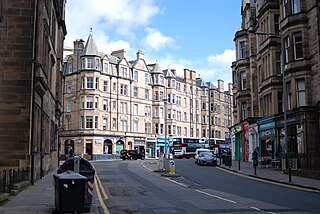
Bruntsfield is a largely residential area around Bruntsfield Place in Southern Edinburgh, Scotland. In feudal times, it fell within the barony of Colinton.
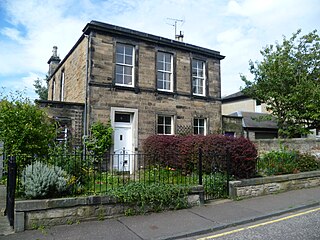
Sciennes is a district of Edinburgh, Scotland, situated approximately 2 kilometres south of the city centre. It is a mainly residential district, although it is also well-known as the site of the former Royal Hospital for Sick Children. Most of its housing stock consists of terraces of four-storey Victorian tenements. The district is popular with students, thanks to its proximity to the University of Edinburgh. Its early history is linked to the presence in the area of the 16th-century Convent of St Catherine of Scienna, from which the district derives its name.

Barclay Viewforth Church is a parish church of the Church of Scotland in the Presbytery of Edinburgh.

Greenhill is a small area of Edinburgh, the capital of Scotland. Situated south of the city centre, Greenhill is normally taken to be part of Bruntsfield, which skirts it to the north. Greenhill borders Marchmont and The Grange to the east, Morningside to the south, and Merchiston, beyond Holy Corner, to the west. It comprises a mixture of Georgian and Victorian villas and some tenement housing.
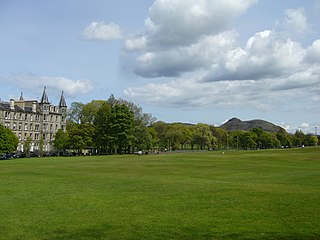
Bruntsfield Links is 35 acres (14 ha) of open parkland in Bruntsfield, Edinburgh, immediately to the south-west of the adjoining Meadows.
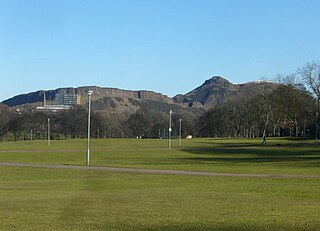
The Burgh Muir is the historic term for an extensive area of land lying to the south of Edinburgh city centre, upon which much of the southern part of the city now stands following its gradual spread and more especially its rapid expansion in the late 18th and 19th centuries. The name has been retained today in the partly anglicised form Boroughmuir for a much smaller district within Bruntsfield, vaguely defined by the presence of Boroughmuir High School, and, until 2010, Boroughmuirhead post office in its north-west corner.

Edward Calvert was a Scottish domestic architect.
Frederick Thomas Pilkington (1832-1898), pupil of his father, was a "Rogue" British architect, practising in the Victorian High Gothic revival style. He designed mostly churches and institutional buildings in Scotland. Typical of his work is the Barclay Church in Edinburgh, a polychrome stone structure with early French Gothic details.

James Gillespie's High School is a state-funded secondary school in Marchmont, Edinburgh, Scotland. It is a comprehensive high school, educating pupils between the ages of 11 and 18, situated at the centre of Edinburgh. Edinburgh Castle and Holyrood Palace are within the catchment area of James Gillespie's High School.

Hippolyte Jean Blanc was a Scottish architect. Best known for his church buildings in the Gothic revival style, Blanc was also a keen antiquarian who oversaw meticulously researched restoration projects.

Sir George Washington Browne was a Scottish architect. He was born in Glasgow, and trained there and in London. He practiced mainly in Edinburgh, where he designed a number of large public and commercial buildings, although his work is found throughout Scotland and Britain.

Robert Morham was the City Architect for Edinburgh for the last decades of the nineteenth century and was responsible for much of the “public face” of the city at the time.

Dunn & Findlay were a firm of Scottish architects operating in the late 19th century and responsible for a number of important commercial buildings including the Scotsman buildings which form part of the Edinburgh Old Town skyline. Each was also independently successful in his own right prior to the partnership. The partnership officially lasted from 1894 until 1903. It was arguably "a marriage of convenience": Dunn providing the skill, Findlay providing the business connections.

John Alexander Carfrae (1868–1947) was a Scottish architect of particular note in the field of innovative school design. He was considered one of the best architects of his generation, but his works were rather limited as he was constrained to the standard board school formats.
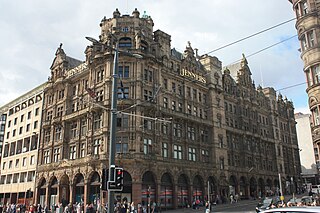
William Hamilton Beattie was a Scottish architect specialising in hotel design in the late 19th century.

John McLachlan was a Scottish architect, based in Edinburgh operating in the late 19th century. He was a brother-in-law to Robert Morham. He has been described as a "minor master".
John Cunningham was a Scottish architect. He designed Lime Street railway station and the original Philharmonic Hall in Liverpool.

Robert Paterson (1825–1889) was a 19th-century Scottish architect. His most famous work is the Cafe Royal in Edinburgh. Almost all his works are in Edinburgh, mainly in the Scots Baronial style, including a number of churches for the United Presbyterian Church.
Robert Macfarlane Cameron RIBA DL (1860–1920) was a 19th/20th century Scottish architect, specialising first in public houses and later in cinemas.



















